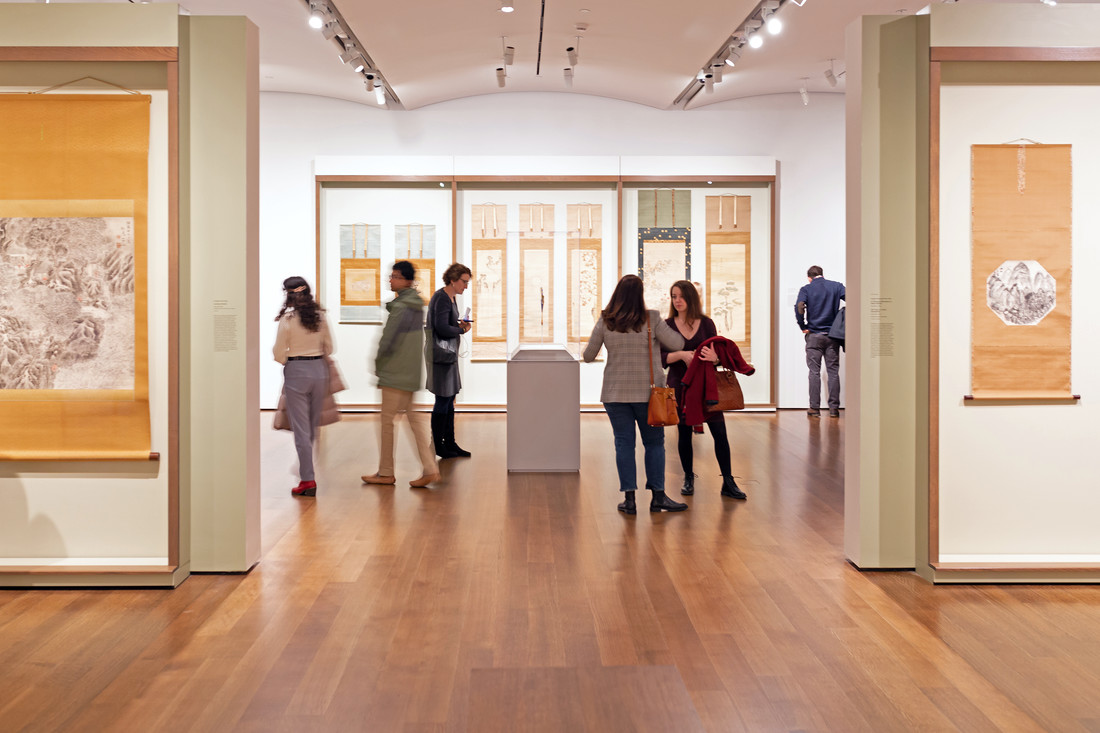2014.514: Seated Medicine Buddha (Sanskrit: Bhaishajyaguru)
Paintings
This object does not yet have a description.
Identification and Creation
- Object Number
- 2014.514
- Title
- Seated Medicine Buddha (Sanskrit: Bhaishajyaguru)
- Other Titles
- Title: Tibetan: Sang gye men la
- Classification
- Paintings
- Work Type
- painting
- Date
- late 14th-mid 15th century
- Places
- Creation Place: South Asia, Tibet
- Culture
- Tibetan
- Persistent Link
- https://hvrd.art/o/352301
Physical Descriptions
- Medium
- Unmounted thangka painting; ink, color, and gold on cloth; with image of a stupa and Tibetan-language inscriptions in black ink on the back.
- Dimensions
- max. H. 57 x W. 45 cm (22 7/16 x 17 11/16 in.)
Provenance
- Recorded Ownership History
-
Walter Norman Koelz, Waterloo, Michigan (by 1953), bequest; to The Nature Conservancy, New York (1989-1990), sold; [through Christie's, New York, October 3,1990] to Robert L. and Amy G. Poster, New York (1990-2014), gift; to Harvard Art Museums
Note: Walter Norman Koelz (1895–1989), University of Michigan.
Acquisition and Rights
- Credit Line
- Harvard Art Museums/Arthur M. Sackler Museum, Gift of Amy and Robert L. Poster, L '65
- Accession Year
- 2014
- Object Number
- 2014.514
- Division
- Asian and Mediterranean Art
- Contact
- am_asianmediterranean@harvard.edu
- Permissions
-
The Harvard Art Museums encourage the use of images found on this website for personal, noncommercial use, including educational and scholarly purposes. To request a higher resolution file of this image, please submit an online request.
Descriptions
- Description
- The central figure in this Tibetan Buddhist painting, or thangka, is Bhaisajyaguru—the buddha of healing and medicine known more commonly as the Medicine Buddha. Seated on an elaborate lotus throne in traditional vajrasana position (with legs crossed, right foot over left), this dark-blue skinned Buddha grasps a myrobalan fruit (emblematic of healing) in his proper right hand; his left hand supports a begging bowl and rests on his lap in dhayanamudra position. He is flanked by two standing bodhisattvas – the red-skinned Suryabhaskara (with an emblem of the sun atop a lotus) to his proper right and the white-skinned Chandrabhaskara (with an emblem of the moon) to his proper left. Stupas containing the Five Symbolic Buddhas—including the historical Buddha Shakyamuni at the top center—sit on a tiered dais behind the main figure. The other figures that surround this assemblage in orderly rows and columns include: the eight emanations of the Medicine Buddha and the female Prajnaparamita, the Sixteen Bodhisattvas, the Sixteen Great Elders or arhats, the Ten Worldly Gods, the Twelve Yaksha Generals, the Guardian Kings of the Four Directions, and depictions of Tibetan Kings, teachers, and attendant figures. On the back of the painting, an image of a stupa is drawn in black ink, the stupa’s proportions and position corresponding to the composition of the main seated Medicine Buddha figure on the front. Within the stupa, three inscriptions written with the Tibetan alphabet appear: two in Sanskrit language, one in Tibetan language. A three-syllable mantra written in Tibetan script is repeatedly inscribed along the periphery of the stupa, each positioned to correspond to the placement of one of the surrounding figures (ie., the bodhisattvas, arhats, yakshas, etc.) depicted on the front. These inscriptions evoked and “installed” the spirit of the deity or historical person into the painting, thereby consecrating the thangka. Probably from Tsang province, Central Tibet (U-tsang).
Exhibition History
- 32Q: 2740 Buddhist II, Harvard Art Museums, Cambridge, 05/31/2018 - 11/27/2018
- Himalayan Art: Art of the Divine Abode, Harvard Art Museums, Cambridge, 01/22/2022 - 05/08/2022
Related Digital Tours
Verification Level
This record has been reviewed by the curatorial staff but may be incomplete. Our records are frequently revised and enhanced. For more information please contact the Division of Asian and Mediterranean Art at am_asianmediterranean@harvard.edu
